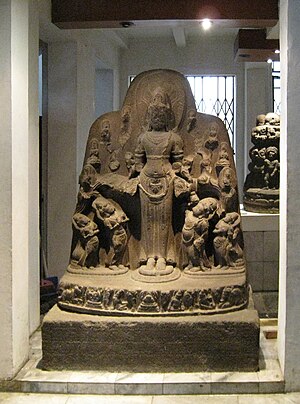User:Immanuelle/Amoghapasha
| This user page or section is currently being expanded by an editor. You are welcome to help in expanding too. If this page has not been changed in several days, please remove this template. This page was last edited by Immanuelle (talk | contribs) 6 months ago. |
| This is a draft being worked on by Immanuelle. It may be too complex at the moment but she wants to get it ready to be an article someday. Others are free to edit it This page was last edited by Immanuelle (talk | contribs) 6 months ago. |

| The English used in this user page may not be easy for everybody to understand. You can help Wikipedia by reading Wikipedia:How to write Simple English pages, then simplifying the page. |
Amoghapasa ( IAST : Amoghapāśa ) is a bodhisattva and one of the manifestations or forms of Avalokiteśvara (also Lokeshvara ), who can take on a feminine or masculine aspect. His name in Sanskrit means “he who has the unshakable cord (amoghapasha)” ; this lace which he generally holds in one hand represents his power to fish out lost beings far from the path. Its Chinese name is Bukongjuansuo Guanyin不空羂索觀音, Japanese Fukūkensaku Kannon [1] . This name literally means Amoghapāśa-avalokiteśvara .
The oldest known text mentioning him is Amoghapasha hridaya sutra translated into Chinese by Jnanagupta in 587, which became the first chapter of a work describing the various rituals concerning him, Amoghapasha kalparaja . Its first known figures date from the VIII century. century . He is most often represented with four, six or eight arms, and sometimes four servants including Tara and Hayagriva [2] .
At the Kasuga-taisha shrine in Nara, he is said to be the same as the Shinto god of martial arts Takemikazuchi-no-mikoto, probably because he wears a deer skin which was the god's mount in Nara. [3]
Equivalents
changeKasuga no Kami has five components each of which has a corresponding Buddha.[4]
| Shrine facility | Shinto part | Buddhist part |
|---|---|---|
| first hall[5] | Takemikazuchi-o | Amoghapasa[6] |
| second hall[5] | Futsunushi | Bhaisajyaguru |
| third hall[5] | Ame no Koyane | Kṣitigarbha |
| fourth hall[5] | Himegami | Ekādaśamukha |
| Wakamiya Shrine[7][8] | Ame-no-Oshikumone | Manjushri or Avalokiteśvara.[9] |
Notes and references
change- ↑ aussi Fukūkenjaku Kannon
- ↑ J A Schoterman Ancient Indonesian Sculpture, Marijke J. Klokke &Pauline C. M. Lunsingh Scheurleer, p. 154-157
- ↑ Allan G. Grapard The Protocol of the Gods: A Study of the Kasuga Cult in Japanese History, University of California press p. 82-83
- ↑ Ten Grotenhuis, Elizabeth (1999). Japanese mandalas : representations of sacred geography. University of Hawai'i Press. ISBN 0824820002. OCLC 39181008.
- ↑ 5.0 5.1 5.2 5.3 "Main Sanctuary". www.kasugataisha.or.jp. Archived from the original on 2019-06-24. Retrieved 2019-03-28.
- ↑ https://kuscholarworks.ku.edu/bitstream/1808/17426/1/Fowler.pdf
- ↑ https://www.mlit.go.jp/tagengo-db/common/001559851.pdf
- ↑ "Wakamiya Shrine | Search Details". Japan Tourism Agency,Japan Tourism Agency. Retrieved 2024-03-20.
- ↑ Giolai, Andrea (2020-09-22). "Encounters with the Past: Fractals and Atmospheres at Kasuga Wakamiya Onmatsuri". Journal of Religion in Japan. 9 (1–3): 213–247. doi:10.1163/22118349-00901002. ISSN 2211-8349.